In 2010, Norman Y. Mineta San Jose International Airport (SJC) opened its brand-new Terminal B. Silicon Valley had survived the dot-com crash, and the greater Bay Area was just starting to come out of the 2008 Great Recession. Established giants like Google and Apple were rebooting, and new high-tech companies were growing like wildflowers. In short, the local business community was thriving and ready for SJC to expand.
In 2010, Norman Y. Mineta San Jose International Airport (SJC) opened its brand-new Terminal B. Silicon Valley had survived the dot-com crash, and the greater Bay Area was just starting to come out of the 2008 Great Recession. Established giants like Google and Apple were rebooting, and new high-tech companies were growing like wildflowers. In short, the local business community was thriving and ready for SJC to expand.
 As it turned out, the new terminal, a host of other modernization projects and the subsequent addition of two more gates in 2017 still wasn’t enough to support the airport’s unprecedented passenger growth.
As it turned out, the new terminal, a host of other modernization projects and the subsequent addition of two more gates in 2017 still wasn’t enough to support the airport’s unprecedented passenger growth.
So the city-owned airport built a $58 million interim facility to serve its rising passenger volume until more permanent gates could be added. Five temporary gates opened in summer 2019, and a sixth opened a few months later.
Southwest Airlines, SJC’s largest carrier, leases all six of the interim gates as well as eight others in the permanent Terminal B concourse.
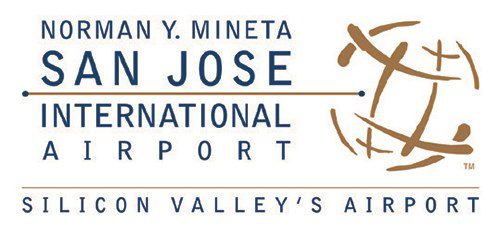
|
facts&figures Project: Interim Gates Facility Location: Norman Y. Mineta San Jose Int’l Airport, Terminal B Owner: City of San Jose Cost: $58 million Scope: 6 gates Strategy: Fast-tracked interim facility will serve growing number of travelers & airlines until permanent gates can be added in 5-7 years; new boarding bridges will not need to be moved; progressive design-build guaranteed maximum price delivery methodology used Funding: Capital improvement funds Construction: July 2018-Nov. 2019 General Contractor: Hensel Phelps Architect of Record: Fentress Architects Structural Engineering: Walter P Moore Structured Collaborative Planning Consultant: Org Metrics Civil Engineers: AECOM Airfield Planning: AERO Systems Engineering Terminal Planning: Landrum-Brown Code & Life Safety Consultant: Jensen Hughes Fire Protection: Transbay Fire Protection Mechanicals: Critchfield Mechanical Electrical: Rosendin Electric Metal Panels: BT Mancini Framing, Drywall & Plaster: Magnum Drywall Boarding Bridge Manufacturer: JBT AeroTech Boarding Bridge Engineering & Design: AERO Systems Engineering Turn-Key Boarding Bridge Provider: AERO BridgeWorks Utilities, Earthwork & Paving: Graniterock Preconditioned Air & Ground Power: ITW-GSE Associated Engineering & Design Services: AERO Systems Engineering Seating: Arconas Food Service Consultant: The Marshall Associates Food & Beverage Concessions: Café X; Yo-kai Express; HMSHost Retail Concessions: Hudson News Digital Signage: Clear Channel Airports Of Note: Facility includes high-tech features such as robotic food/beverage concessions & all-digital advertising signage |
Over the past five years, SJC has been one of the country’s fastest-growing airports. In 2018, it served 14.3 million passengers, a 52% increase from 2014. By year-end 2019, SJC expected to serve 15.7 million travelers, almost 10% more than the previous year.
Given the airport’s unprecedented growth and the addition of several international carriers, passenger gates were at capacity. Some airlines, Southwest and Alaska in particular, were operating out of two terminals, which created operational inefficiencies, not to mention long walks for some connecting passengers.
“It was very inefficient and confusing for our passengers,” says Judy Ross, assistant director of Aviation at SJC. “We needed gates, and we needed them fast.”
With air carriers clamoring for more capacity, airport and city officials agreed that adding an interim gates facility to Terminal B was the quickest and most efficient solution. The new gates are designed to handle up to 10,800 travelers per day (4 million per year)—about 50% more than Terminal B’s original 12 gates can accommodate.
Fast-Track Solution
The original plan called for four temporary gates, but the airport and city ultimately entered into a design-build contract with general contractor Hensel Phelps and Fentress Architects to build six. Contracts were signed in June 2018, and construction began in July. The first five gates opened for business 11 months later in June 2019; and the last gate was ready in November, just in time for the Thanksgiving holiday.
SJC plans to replace the interim gates with permanent gates in five to seven years. At less than 30 feet wide, the facility fits between the future site for the permanent building and the associated passenger boarding bridges. As such, it can remain in use while the permanent building is constructed.
AERO Systems Engineering provided airside planning/engineering services; and AERO BridgeWorks furnished and assembled the boarding bridges and associated equipment. “Six new aircraft parking positions serviced by new boarding bridges were designed to service a range of ADG-III aircraft, including the Boeing 737, the dominant aircraft in the Southwest Airlines fleet,” informs David Meyers, project manager with AERO Systems Engineering.
 Meyers and Steve Henry, project manager with AERO BridgeWorks, agree that the project exemplified the benefits of the design-build approach—specifically early and continual collaboration. “Near the end of the project when SJC opted to add a sixth gate, we were able to quickly lock in the added gate for fabrication and delivery in a few short months,” says Henry.
Meyers and Steve Henry, project manager with AERO BridgeWorks, agree that the project exemplified the benefits of the design-build approach—specifically early and continual collaboration. “Near the end of the project when SJC opted to add a sixth gate, we were able to quickly lock in the added gate for fabrication and delivery in a few short months,” says Henry.
The design placed all the jet bridges in their permanent positions, so the airport won’t have to relocate them when it adds permanent gates. “We will just have to raise their height by adding a pedestal,” Ross explains. “To a great extent, we will be able to construct the permanent extension without interrupting operations on these six temporary gates.”
 Fai Ali, a civil engineer at SJC, notes that the interim facility was designed in modules, with each bay separate from the others. SidePlate® construction methods allowed structural plates to be welded at the factory then bolted together on site. “This process made the project much more environmentally sustainable by allowing us eventually to remove and reprocess a lot of the steel structure,” explains Ali.
Fai Ali, a civil engineer at SJC, notes that the interim facility was designed in modules, with each bay separate from the others. SidePlate® construction methods allowed structural plates to be welded at the factory then bolted together on site. “This process made the project much more environmentally sustainable by allowing us eventually to remove and reprocess a lot of the steel structure,” explains Ali.
All told, the project required about 350 tons of structural steel, 47,000 square feet of exterior steel panels and 1,750 cubic yards of concrete.
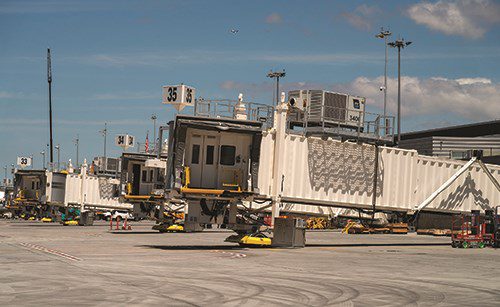
Given the project’s tight schedule, the design-build team continually looked for opportunities to expedite construction. For example, contractors started concrete work on one end of the facility while steel bolting work began on the other end. “We came up with innovative ways to move forward in the field as we went along,” Ali remarks. “It saved a lot of time; everyone was accountable.”
 Knowing the facility would be temporary, Fentress Architects embraced a “minimalistic aesthetic” when designing the interior. To achieve uniformity, the interim facility’s paint colors and warm tones are similar to those used throughout Terminal B. Polished concrete floors and an open ceiling design with exposed structures and building systems help mitigate future materials waste.
Knowing the facility would be temporary, Fentress Architects embraced a “minimalistic aesthetic” when designing the interior. To achieve uniformity, the interim facility’s paint colors and warm tones are similar to those used throughout Terminal B. Polished concrete floors and an open ceiling design with exposed structures and building systems help mitigate future materials waste.
Holdrooms include seating, with power, for up to 613 travelers. Hudson News has a small retail concession, and HMSHost operates Island Brews, which offers travelers grab-and-go-salads and sandwiches as well as coffee and alcoholic beverages that can be taken and enjoyed at their boarding gates.
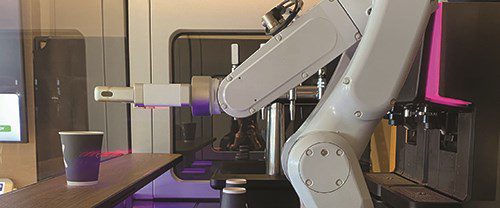
Café X and Yo-kai Express are delighting travelers by using robotic devices to serve gourmet coffees and ramen, respectively—a notably high-tech concessions approach for a U.S. airport.
Clerestory windows and LED light pendants linked to photometric sensors that dim lights during daylight hours are green features that also serve as wayfinding elements for travelers. Compared with Terminal B, the interim gate facility reduces lighting power density by 68%. Acoustical panels placed near the clerestory windows mimic skylight patterns throughout Terminal B.
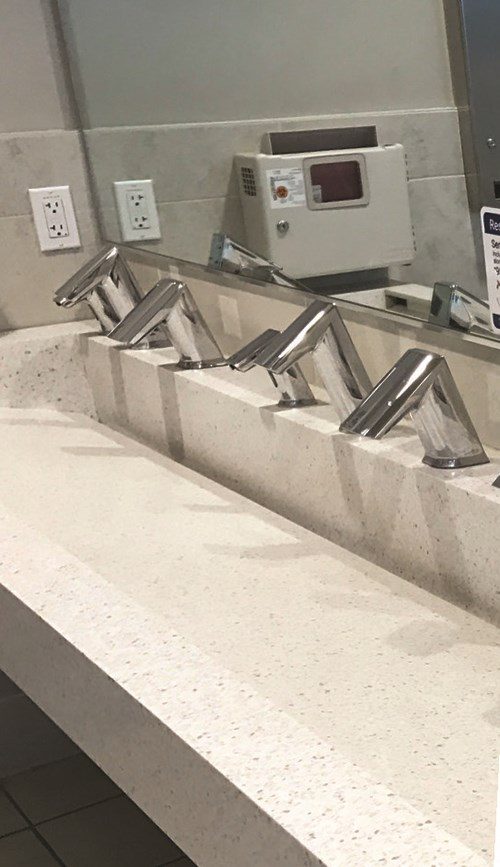
Two sets of restrooms were installed, with low-flow fixtures that use 40% less potable water than standard fixtures. Hand washing stations allow users to soap, wash and dry their hands without leaving the sink area.
Building Trust
 David Valentine, project development director for Hensel Phelps, credits the design-build contract for providing the team with enough flexibility to design the project and have materials fabricated, delivered and installed within a very short timeframe. “We were able to go from the original four gates to a fifth gate and ground-loaded sixth position, which was then changed to a jet bridge gate, and finally to a sixth gate—and made those changes under an extremely tight schedule,” he remarks. “With a more traditional contract, the design process alone could have taken 11 months before it was complete enough for contractors to bid on.”
David Valentine, project development director for Hensel Phelps, credits the design-build contract for providing the team with enough flexibility to design the project and have materials fabricated, delivered and installed within a very short timeframe. “We were able to go from the original four gates to a fifth gate and ground-loaded sixth position, which was then changed to a jet bridge gate, and finally to a sixth gate—and made those changes under an extremely tight schedule,” he remarks. “With a more traditional contract, the design process alone could have taken 11 months before it was complete enough for contractors to bid on.”
 Curt Fentress, design principal at Fentress Architects, agrees: “The design-build delivery method and mutual trust between owner, architect, contractor and subconsultants enabled this project to be delivered on an incredibly tight schedule. There were times when the collaborative process enabled consensus-based decisions to be made, documented and deployed to the field within the same day.”
Curt Fentress, design principal at Fentress Architects, agrees: “The design-build delivery method and mutual trust between owner, architect, contractor and subconsultants enabled this project to be delivered on an incredibly tight schedule. There were times when the collaborative process enabled consensus-based decisions to be made, documented and deployed to the field within the same day.”
Ross notes that the commitment of various trades working on the project was also pivotal. “They worked double shifts six, sometimes seven, days a week,” she remarks. “It was a very aggressive schedule, and we had to establish trust in one another.”
 The project team hired Org Metrics to foster that process and lead structured collaborative partnering throughout the project. “Having a formal facilitator from the outside helped keep us focused and on task,” Ross explains. “When we left meetings, everyone had their directions and responsibilities and were empowered to make things happen.”
The project team hired Org Metrics to foster that process and lead structured collaborative partnering throughout the project. “Having a formal facilitator from the outside helped keep us focused and on task,” Ross explains. “When we left meetings, everyone had their directions and responsibilities and were empowered to make things happen.”
With the new gates in place, SJC’s airlines are finally getting the relief they have needed. “The interim gates allow us to concentrate our sizable operations at SJC into a footprint of contiguous gates and holdrooms,” says Andrew Watterson, executive vice president and chief revenue officer for Southwest. “Centralized operations make baggage delivery and turn times more efficient. Plus, our customers who have to change aircraft don’t have a long walk to board their next flight.”
The added gates provide breathing room for all the airlines operating at SJC, Ross adds.
|
High-Tech Ads for High-Tech Market Google, Apple, Oracle, Facebook—all of these storied Silicon Valley companies, plus a plethora of high-tech startups, are close neighbors of Norman Y. Mineta San Jose International Airport (SJC).
That said, what better location than SJC to launch the nation’s first all-digital airport advertising program? “As the tech capital of the world, San Jose made perfect sense as the place to reinvent airport advertising,” says John Moyer, senior vice president of Development for Clear Channel Airports. “More than 100 tech companies are located within 18 miles of SJC. It is the country’s fastest-growing airport, with nearly 80 months of consecutive year-over-year passenger traffic growth.”
Clear Channel Airports, a unit of Clear Channel Outdoor Holdings Inc., committed $6.5 million to the signage buildout. Google Cloud and Alaska Airlines went live on the all-digital platform in mid-November. These inaugural foundation sponsors, as well as other companies, will be able to engage with more than 15 million passengers who pass through the airport annually. “The immersive digital experience provides exclusive brands with high flexibility for relevant speed and content to tell their story and to surprise, delight and wow the highly desirable SJC audience,” Moyer elaborates. Moreover, the new program potentially doubles advertising revenue for SJC and Clear Channel Airports, setting a new bar for revenue-per-passenger from airport advertising. Importantly, the airport garners 55% of gross revenues—“no small number,” Riddle points out. Going Big Moyer describes SJC’s new program as the most advanced airport advertising program in the U.S., and possibly the world. The media network includes 82 new digital LCD and LED screens located in high-traffic areas such as security sections, gathering spots in the terminal, gates areas and baggage claims. The installation features large, uniquely shaped digital mesh screens placed against walls; 32-foot LED soffit screens with integrated flight information displays; 12-foot-tall, 360-degree LED column wraps; and 86-inch LCD screens. All told, nearly 5,000 square feet of new digital signage has been installed in landside and airside spaces through the facility.
The program also marks the introduction of Clear Channel Outdoor RADAR, the company’s suite of data-driven strategies for planning, amplification and measurement. Riddle notes that the all-digital approach has practical and environmental advantages. “Content can be updated remotely in a matter of hours versus having to organize security escorts so advertisers can tear down and reinstall static displays,” he explains. For the first time ever, leading global companies are able to saturate an entire airport with their messages, Moyer adds. “The exclusive foundation sponsorships and campaign advertising programs represent an industry pivot, transforming airport media from a screen-by-screen, terminal-by-terminal or even network-by-network basis to an airport-wide takeover.” “It’s a paradigm shift,” agrees Riddle. |


 “I could probably kick a soccer ball really hard and hit any one of those companies’ campuses,” jokes Scott Riddle, the airport’s acting supervising property manager.
“I could probably kick a soccer ball really hard and hit any one of those companies’ campuses,” jokes Scott Riddle, the airport’s acting supervising property manager.
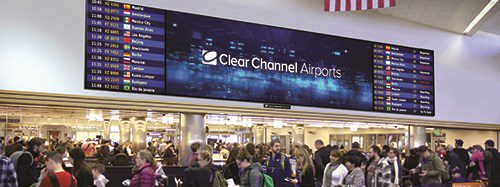
 The new program replaces paper and cardboard advertising with a “data-driven digital canvas,” notes Moyer. “The combination of iconic digital signs and smaller eye-level digital networks allows advertisers to tailor messaging for specific SJC consumer groups.”
The new program replaces paper and cardboard advertising with a “data-driven digital canvas,” notes Moyer. “The combination of iconic digital signs and smaller eye-level digital networks allows advertisers to tailor messaging for specific SJC consumer groups.”

